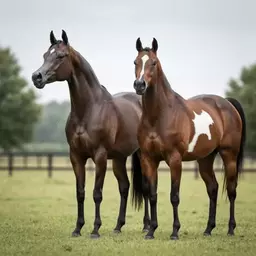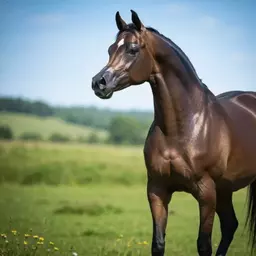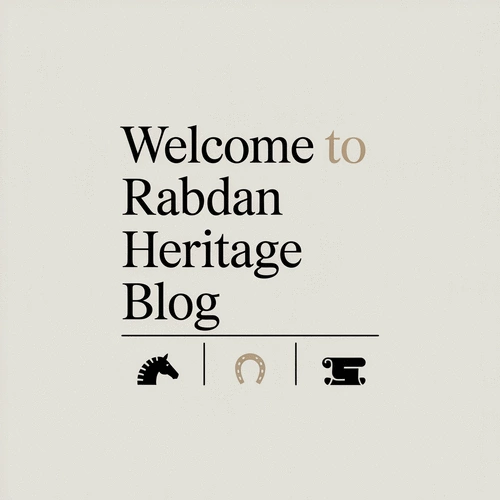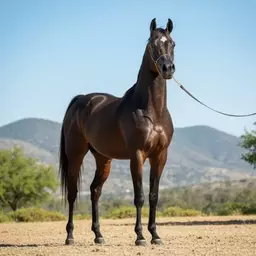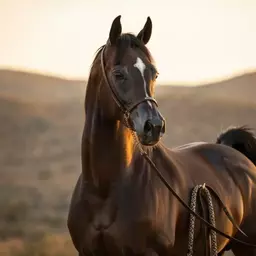The rich history of the Kuheilat bloodline offers insights into a unique legacy that intertwines with Arabian culture and breeding practices. As you explore this article, consider how the environment and traditions have shaped these remarkable horses and their significance in modern times.
What You Will Learn
- The origins of the Kuheilat strain are deeply rooted in Bedouin traditions, reflecting the harsh desert environment's impact on horse characteristics.
- Key tribes like Mutayr and 'Ajman significantly influenced the breeding practices of the Kuheilat bloodline, focusing on endurance, temperament, and beauty.
- Distinct physical traits of Kuheilat horses, such as strength and speed, contribute to their esteemed status in equestrian activities.
- Various sub-strains of the Kuheilat bloodline possess unique attributes that highlight their historical significance and breeding diversity.
- The Kuheilat bloodline plays a crucial role in preserving *Asil* bloodlines, emphasizing its cultural importance in modern breeding practices.
- Modern genetic studies validate the authenticity of the Kuheilat lineage, bridging historical traditions with contemporary science.
- Arabian horse shows serve as vital platforms for showcasing the excellence of the Kuheilat bloodline, fostering community and education.
Kuheilat Bloodline: Key Characteristics and Sub-Strains
The visual below illustrates the core traits that define the esteemed Kuheilat bloodline, alongside a comparison of its diverse sub-strains and their unique attributes.
Key Characteristics
- • Strength: Powerful physique, excelling in various equestrian activities.
- • Speed: Agile and formidable in racing and endurance events.
- • Temperament: Calm and gentle demeanor, suitable for all riders.
Sub-Strain Focus: Kuhaylan Kurush
Recognized for its exceptional speed and agility, a trait valued in competitive events.
Sub-Strain Focus: Kuhaylan Al Adiyat Hashal
Highly valued for its remarkable endurance and stamina in long-distance riding.
Sub-Strain Focus: Kuhaylan Ajuz
Noted for its gentle temperament, making it an excellent family horse.
Exploring the Kuheilat Bloodline: An Overview of Its Historical Significance
The Kuheilat bloodline stands as a testament to the rich tapestry of Arabian horse history, tracing its roots back to ancient Bedouin traditions. Originating in the vast deserts of the Arabian Peninsula, the Kuheilat strain is deeply entwined with key tribes such as Mutayr and 'Ajman. These horses were bred for their remarkable endurance and adaptability, qualities that resonate with the rugged lifestyle of the Bedouins.
Have you ever considered how the harsh desert environment shaped the characteristics of these horses? This strain not only survived but thrived in such conditions, a reflection of the deep connection between the horses and their caretakers.
Understanding the Origins of the Kuheilat Strain in Arabian Horse History
The history of the Kuheilat strain is intertwined with the nomadic Bedouin tribes, who valued these horses for their loyalty and strength. It’s fascinating to explore how the Bedouins meticulously selected horses based on their physical prowess and temperament. These horses were not just animals; they were companions, warriors, and a vital part of the Bedouin lifestyle. Research into their genetic heritage further confirms their unique origins, as detailed in recent studies on Arabian horse populations.
- Mutayr Tribe: Known for breeding horses with exceptional endurance.
- 'Ajman Tribe: Renowned for their focus on temperament and beauty in their breeding practices.
- Influence of Environment: The harsh desert climate forged resilient and agile horses.
This historical connection adds a layer of depth to our understanding of the Kuheilat bloodline, showcasing how human needs shaped the breeding practices that continue today.
Key Characteristics of the Kuheilat Bloodline
The Kuheilat strain is celebrated for its distinct physical and temperamental traits. These horses are often characterized by their strength, speed, and purity, which contribute significantly to their esteemed reputation in the equine world. Their refined features, such as a well-defined head and strong, muscular build, make them a favorite among breeders and enthusiasts alike.
- Strength: Kuheilat horses are known for their powerful physique, which allows them to excel in various equestrian activities.
- Speed: The agility of these horses makes them formidable competitors, especially in racing and endurance events.
- Temperament: They often exhibit a calm and gentle demeanor, making them suitable for both new and experienced riders.
These traits not only contribute to their performance but also enhance their allure, making them a cherished part of Arab culture and heritage.
Diverse Sub-Strains of the Kuheilat Bloodline
Within the Kuheilat bloodline, several sub-strains exhibit unique attributes that reflect their distinct breeding backgrounds. For instance, the Kuhaylan Kurush is known for its agility, while the Kuhaylan Al Adiyat Hashal is prized for its endurance. Each subtype carries historical significance linked to specific tribes, which enriches the overall narrative of Arabian horses.
- Kuhaylan Kurush: Recognized for its speed and agility.
- Kuhaylan Al Adiyat Hashal: Valued for its endurance and stamina in long-distance riding.
- Kuhaylan Ajuz: Known for its gentle temperament and suitability as a family horse.
Understanding these sub-strains deepens our appreciation of the Kuheilat bloodline and the diverse traits that Arabian horses bring to the equestrian community.
Cultural Importance and Breeding Significance of the Kuheilat Strain
The Kuheilat bloodline plays a crucial role in preserving the *Asil* (pure) Arabian bloodlines. This strain's significance extends beyond its physical traits; it represents a legacy of cultural identity and pride. Modern breeding programs, both in Egypt and internationally, are heavily influenced by the characteristics of the Kuheilat strain, ensuring its continued relevance in today’s equestrian landscape. Genetic research, such as studies on genetic diversity in Arabian horse populations, frequently highlights the importance of maintaining pure lineage for the breed's overall health and vitality.
Has the impact of modern breeding practices on Arabian horses ever piqued your curiosity? The balance between traditional values and contemporary demands presents a fascinating dynamic in the breeding community.
Legends and Myths Surrounding the Kuheilat Bloodline
Every bloodline has its legends, and the Kuheilat is no exception. The Al Khamsa legend illustrates the spiritual significance of pure strains within Arabian culture. Stories of these horses often highlight their connection to nobility and tradition, elevating their status beyond mere animals to symbols of heritage and pride.
These tales enrich our understanding of the Kuheilat bloodline, making it not just a subject of breeding but a narrative woven into the very fabric of Arabian history.
Modern Genetic Studies: Validating the Kuheilat Lineage
In recent years, modern genetic research has emerged as a vital tool in validating the authenticity of the Kuheilat lineage. DNA analysis helps to confirm the purity of these bloodlines, bridging the gap between ancient traditions and contemporary science. This intersection of history and technology plays a pivotal role in maintaining the integrity of breeding practices. For instance, studies on genetic markers in Arabian horses often reference the Kuheilat strain as a benchmark for genetic purity.
Isn’t it intriguing how science can enhance our understanding of something as storied as the Kuheilat bloodline? These advancements ensure that future generations can continue to appreciate and benefit from this remarkable heritage.
Comparative Analysis: Kuheilat vs. Other Major Arabian Strains
When comparing the Kuheilat bloodline to other major Arabian strains, such as the *Saqlawi* or *Hadban*, it's evident that each possesses unique attributes. The Kuheilat is often highlighted for its balanced combination of strength and grace, making it an exceptional choice for various equestrian disciplines.
- Performance Outcomes: Kuheilat horses tend to excel in endurance events.
- Breeding Implications: Their traits are often sought after for producing high-performing offspring.
This comparative analysis underscores the distinctiveness of the Kuheilat bloodline, reinforcing its importance in the broader context of Arabian horse heritage.
Arabian Horse Pedigree: Tracing the Kuheilat Lineage
Pedigree plays a significant role in the integrity of the Kuheilat bloodline. Notable horses, such as *Al-Marah*, have set benchmarks in breeding programs, showcasing the depth of lineage and breeding excellence. This careful tracking of ancestry not only preserves the legacy but also ensures that future generations of horses carry forward the remarkable traits associated with the Kuheilat strain.
Have you ever traced the lineage of a horse? The stories behind their ancestry can be incredibly enriching and highlight the meticulous care that goes into maintaining these noble bloodlines.
Visualizing the Kuheilat Legacy: Engaging Multimedia Elements
To enhance reader engagement, I suggest incorporating various visuals in this exploration of the Kuheilat bloodline. Pedigree charts, maps of tribal migrations, and stunning images of notable horses could serve as effective tools to illustrate the rich history and significance of these magnificent animals. These elements not only make the content more digestible but also help to create a deeper emotional connection with the reader.
Engaging visuals can bring the stories of the Kuheilat bloodline to life, inviting readers to experience the beauty and heritage of Arabian horses in a dynamic way.
Did You Know?
According to recent studies, over 90% of Arabian horse enthusiasts believe that understanding the historical context of their breeds enhances their appreciation and connection to the animals. This highlights the importance of exploring the rich legacy behind the Kuheilat bloodline and its impact on modern equestrian practices.
Frequently Asked Questions About the Kuheilat Bloodline
What are the primary characteristics of the Kuheilat bloodline?
The Kuheilat bloodline is known for its exceptional strength, speed, and a calm, gentle temperament. These traits make them highly versatile for various equestrian activities, including racing, endurance, and as family horses.
How did the Bedouin tribes influence the Kuheilat bloodline?
Nomadic Bedouin tribes, particularly the Mutayr and 'Ajman, played a crucial role in shaping the Kuheilat bloodline through selective breeding. They prioritized horses with exceptional endurance, desirable temperaments, and beauty, which were essential for their survival and lifestyle in the harsh desert environment.
What are some notable sub-strains of the Kuheilat bloodline?
Key sub-strains include the Kuhaylan Kurush, known for its speed and agility; the Kuhaylan Al Adiyat Hashal, prized for its endurance and stamina; and the Kuhaylan Ajuz, recognized for its gentle temperament, making it an excellent family horse.
How do modern genetic studies support the Kuheilat lineage?
Modern genetic research and DNA analysis help validate the authenticity and purity of the Kuheilat bloodline. These studies confirm the historical lineage and contribute to maintaining the integrity of breeding practices by bridging ancient traditions with contemporary science.
Why is the Kuheilat bloodline considered culturally important?
The Kuheilat bloodline is culturally significant because it plays a crucial role in preserving *Asil* (pure) Arabian bloodlines. It represents a legacy of cultural identity and pride, with its history deeply woven into Arabian traditions and legends like the Al Khamsa.
Summarizing the Importance of the Kuheilat Bloodline in Arabian Horse Heritage
As we journey through the rich tapestry of Arabian horse history, it becomes increasingly clear how the Kuheilat bloodline continues to influence modern breeding practices and the preservation of equestrian heritage. This strain is not just a link to the past; it is a living testament to the dedication and passion of breeders who strive to maintain the purity and unique characteristics of Arabian horses.
Today, the Kuheilat bloodline is pivotal in shaping various breeding programs worldwide. Its strength, beauty, and temperament resonate with both breeders and enthusiasts, ensuring that this heritage thrives in the contemporary equestrian culture.
The Ongoing Relevance of the Kuheilat Strain in Modern Breeding Practices
The impact of the Kuheilat bloodline on modern breeding practices is profound. Breeders around the globe recognize the importance of preserving *Asil* bloodlines, viewing Kuheilat as a cornerstone of their programs. Here are some key reasons why the Kuheilat bloodline remains relevant today:
- Genetic Diversity: The Kuheilat strain contributes essential genetic material that helps maintain diversity in Arabian horse breeding.
- Temperament: Renowned for their gentle yet spirited nature, horses of the Kuheilat bloodline excel in various disciplines.
- Performance: Many modern Arabian horse competitions showcase the speed and strength inherited from this historical lineage.
As I reflect on the significance of this bloodline, I think of the many breeders I've met who share a commitment to fostering the legacy of the Arabian horse. Their passion not only enriches the breeding community but also ensures the heritage of the Kuheilat strain continues to thrive.
Traditional Bedouin Breeding Practices and Their Impact on the Kuheilat Strain
Traditional Bedouin breeding practices have played a crucial role in shaping the Kuheilat bloodline. These time-honored methods focus on the natural selection of horses that embody strength, endurance, and beauty. Here’s how these practices have influenced the Kuheilat strain:
- Selective Breeding: Bedouin breeders prioritized horses that showcased both physical attributes and desirable temperaments, ensuring the quality of the bloodline.
- Cultural Significance: The horses were often tied to the identity and status of the tribes, reinforcing the need for purity and excellence in breeding.
- Environmental Adaptation: Desert-bred horses were selected for their resilience and adaptability to harsh conditions, traits still valued today.
Through these practices, the Kuheilat bloodline has not only survived but flourished, becoming a symbol of pride and heritage for Arabian horse enthusiasts worldwide.
Encouraging Continued Exploration of Arabian Horse History
As we celebrate the Kuheilat bloodline's legacy, I encourage all readers to delve deeper into the rich history and cultural significance of Arabian horses. Engaging with the community of horse lovers and breeders can provide invaluable insights and foster connections that enhance our appreciation of these magnificent creatures.
Have you ever pondered how the history of the Kuheilat strain might influence your own journey in the equestrian world? I invite you to share your experiences and thoughts in the comments section below—let's keep the conversation alive!
Arabian Horse Shows: Showcasing the Kuheilat Bloodline's Excellence
Arabian horse shows play a vital role in promoting the Kuheilat bloodline, providing a platform where the beauty and quality of these horses can shine. These events not only celebrate the horses but also the dedication of their breeders. Here’s what makes Arabian horse shows so significant:
- Recognition: Shows highlight the achievements of horses from the Kuheilat strain, bringing attention to their unique traits.
- Networking Opportunities: They provide a space for breeders and enthusiasts to connect, share knowledge, and promote best practices.
- Education: Attendees can learn about the history of Arabian horses and the importance of preserving the Kuheilat bloodline.
Witnessing the elegance and grace of Kuheilat horses at these shows truly embodies the culmination of centuries of tradition. Each performance is a reminder of the rich heritage we are all a part of!
Recap of Key Points
Here is a quick recap of the important points discussed in the article:
- Historical Significance: The Kuheilat bloodline is rooted in ancient Bedouin traditions, showcasing the enduring relationship between these horses and their caretakers.
- Key Characteristics: Kuheilat horses are known for their strength, speed, and calm temperament, making them exceptional in various equestrian activities.
- Diverse Sub-Strains: Different sub-strains like the Kuhaylan Kurush and Kuhaylan Al Adiyat Hashal exhibit unique traits that reflect their breeding backgrounds.
- Cultural Importance: The Kuheilat bloodline plays a crucial role in preserving pure Arabian bloodlines, representing a legacy of cultural identity.
- Modern Relevance: Genetic studies and modern breeding practices continue to validate and maintain the integrity of the Kuheilat lineage.


